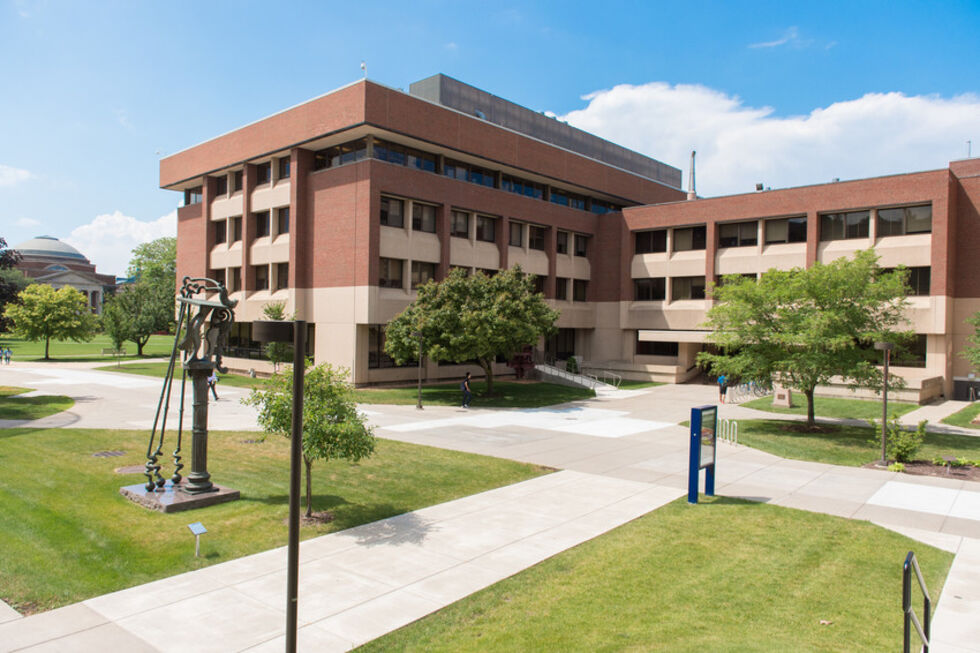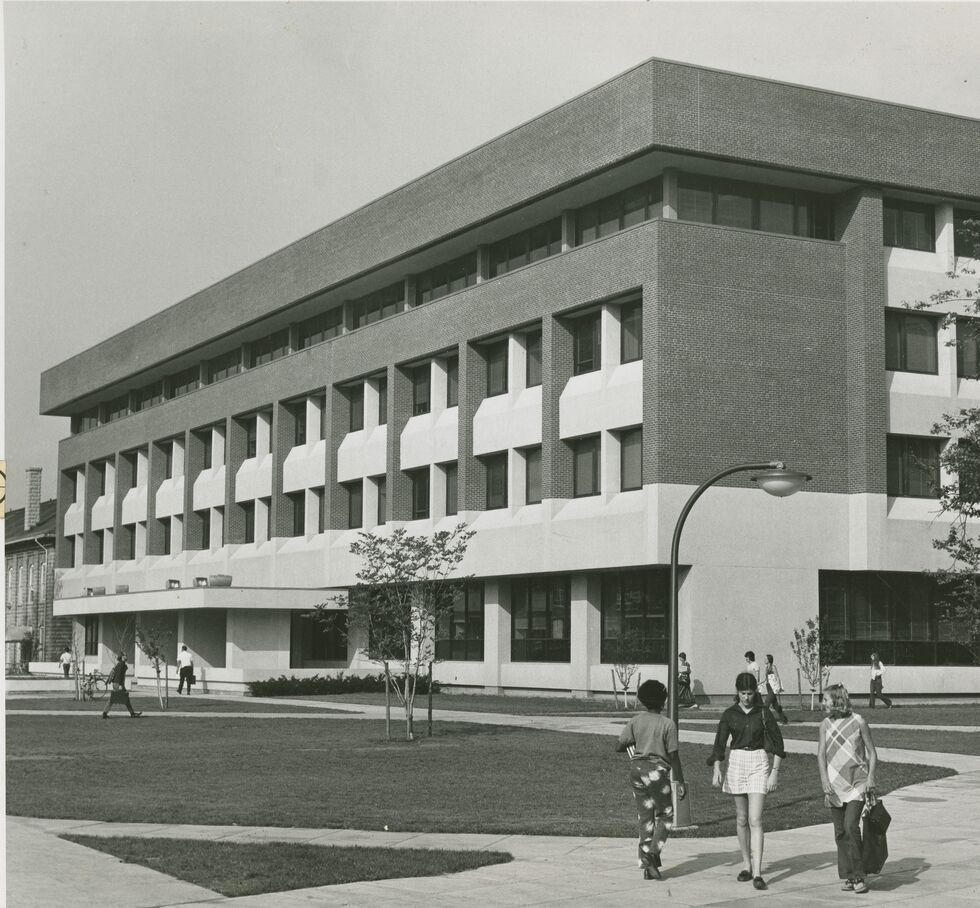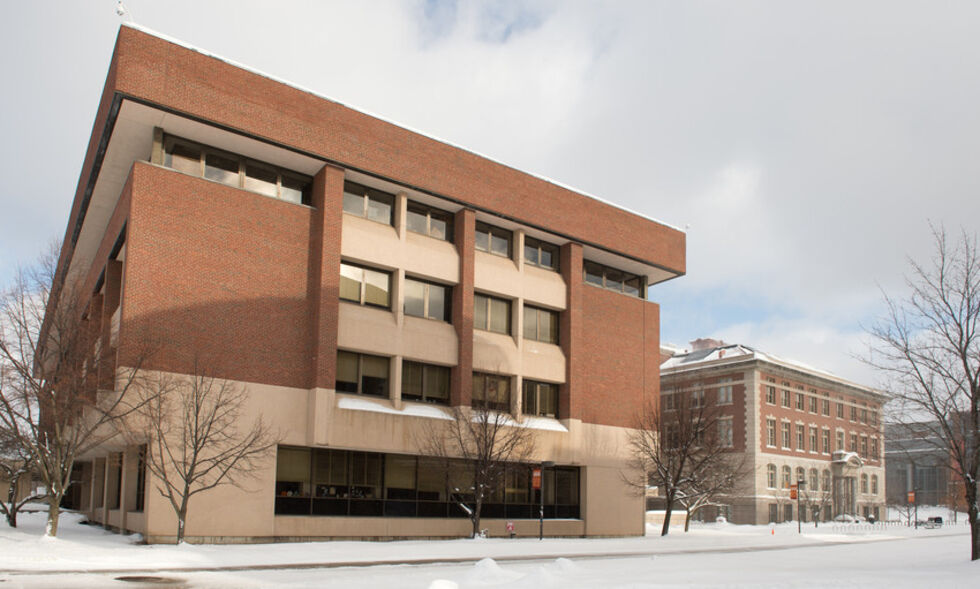Link Hall
"Link Hall" by King & King, Syracuse , 1968-1970
Link Hall currently houses the College of Engineering. In 1952, the College of Applied Science restructured into the College of Engineering, which included multiple buildings such as Hinds Hall and Link Hall. Link Hall formerly housed Industrial Engineering, Electrical Engineering, Mechanical and Aerospace Engineering, and the Metallurgy division of the Department of Chemical Engineering and Metallurgy. The building has been renovated and added onto twice: the 2000 renovation created a new suite of state-of-the-art laboratories for environmental research on the fourth floor; the addition of “Link+” in 2008 added five stories which house research labs and connected Link Hall to Slocum Hall. Today, the building contains classrooms, offices, and labs for the University’s College of Engineering and Computer Science.
Funding for Link Hall was a donation from Edwin Albert Link and his wife Marian Clayton Link, who was an alumnae and trustee of SU. The building was also named for Edwin Albert Link, who was an engineer, inventor, underwater explorer, author, and industrialist. Link invented the on-the-ground pilot trainer, which was used to prepare thousands of pilots for air combat in WWII. He also perfected the Apollo Mission and lunar module simulators, which readied astronauts to voyage into outer space. The building was the second in a two-part engineering complex, the first building being Hinds Hall (now the School of Information Studies). Link Hall’s craftsmanship and construction drew special commendation from the Syracuse Society of Architects.
Link Hall is named after Edwin A. Link born July 26,1904 in Huntington, Indiana. Link moved in 1910 to Binghamton, New York with his parents when they purchased (and renamed) the Link Player Piano and Organ Company. This is where Edwin began his multi-faceted career as an inventor, industrialist and pioneer in flight simulation, underwater archaeology and ocean engineering.
Around 1927 Edwin developed the Link Trainer, a device with a cockpit to mimic the motions and sensations of flying. He used parts from his father’s automatic piano and organ factory to produce his first “Trainer”. In 1929 Edwin founded Link Aeronautical Corp. in Binghamton, NY to market his Link Trainer also known as the “Blue Box”. At first, Edwin’s Link Trainer wasn’t taken seriously and it was considered a toy at amusement parks. Finally, in 1934, the United States Army Air Corps ordered six after a series of air accidents to bolster its pilot training program. During WWII as much as half a million airmen were trained on the Link Trainer, which ultimately created worldwide success. In 1953 Edwin and Marion Link (m. 1931) established The Link Foundation, which provides grants and fellowships in aeronautics, simulation and training, ocean engineering, and energy. It is a robust foundation to this day. After many successful years, Edwin sold Link Aviation in 1954 to General Precision Equipment Corp. After the sale of his company, Edwin began exploration in underwater archaeology and ocean engineering. With his wife, Marion, as a dedicated research partner and their two sons, William Martin and Edwin Clayton, they took a number of voyages. Ultimately, Edwin worked tirelessly to help improve diving equipment so they could go deeper and explore more safely and efficiently. Edwin designed several submersible decompression chambers; most notably, in 1967, the Deep Dive, the first small submersible designed for lockout diving that allowed divers to enter and exit the craft while underwater. On a routine dive in 1973, off the coast of Key West his youngest son, Edwin Clayton and his friend, Albert Stover, were killed due to carbon dioxide poisoning when the Johnson Sea Link became trapped in debris. It was this accident that prompted Edwin to design an unmanned Cabled Observation and Rescue Device (CORD) that could free a trapped submersible. Edwin continued to work and explore until his passing on September 7, 1981. He received an honorary degree from Binghamton University. In 1976, he was inducted into the National Aviation Hall of Fame
SU University Archives; SU Photo and Imaging Archive; Biography of Edwin A. Link. Binghamton University Libraries; The Link Foundation website.


